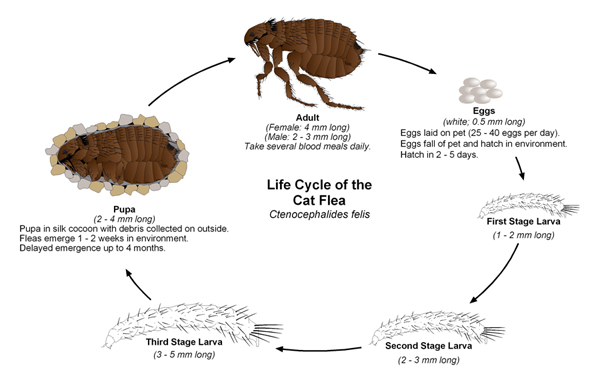Description and Size
Fleas are small, wingless insects ranging in size from approximately 1-10 millimetres in length depending on the species. Almost everybody, especially those with cats or dogs will be familiar with these small biting insects and will have either seen them or the effects of their nuisance bites. Fleas can be recognised by the following features:
- Laterally compressed bodies
- Piercing-sucking mouthparts
- Enlarged hind legs adapted for jumping
- Strong tarsal claws adapted for holding onto their hosts
- Backward pointing hairs and bristles for ease of movement through the hair of a host
- Small antennae which tuck away into special groves in the head
There are an estimated 2,500 species of fleas in the world, approximately 325 of which occur in the continental U.S. Over 94% are associated with mammals, and nearly 6% with birds. Adult fleas typically are about 1/8 inch long, oval, and reddish-brown. They are wingless, and their bodies are very thin, so thin that they can move freely through fur or feathers of their host.
Life Cycle
Fleas mate on their host animal and lay their eggs either onto the animal where they fall to the nest or directly in the nest. The small larvae hatch from the eggs and do not begin to feed on blood like that of their parents but consume the dead skin and other dirt and dust from the host animal. The larvae develop through 3 instars and when fully grown spin a silken cocoon and pupate in the nest of the host. The vibrations of a host often trigger the emergence of the adult flea from the pupal case, enabling it to immediately find a host and begin feeding. The complete life cycle may take from several weeks to many months depending on the species.

Diseases Transmitted to Humans by Fleas
Cat scratch disease – is a bacterial disease caused by Bartonella henselae. People with weak immune systems are at increased risk of getting seriously ill with cat scratch fever. Young cats and kittens are most likely to be the source of human infection and about 40% of cats carry these bacteria at some point in their lives. The infection, which rarely causes disease in cats, is transmitted between cats by fleas. Infected flea droppings on the cat’s fur or claws are the source of human infections, which are spread from the cat to a person by a cat bite, scratch or lick. Cat scratch fever can be prevented by practicing excellent flea control and by avoiding cat bites or scratches.
Plague – is a serious infection of humans caused by a bacteria called Yersinia pestis. It is usually caused by the bite of a flea that has fed on an infected wild animal, such as a rat, chipmunk or prairie dog. It usually causes large sores and abscesses in the glands of the arms and legs. Dogs, and especially cats, can also become infected and can spread the disease to their human companions. While plague has been found in wildlife in many parts of the state including Western Washington, human cases are rare. The most recent human case was in Grant County in 1984. Plague is treatable with antibiotics.
Murine typhus – is a mild form of typhus caused by the bacterium Rickettsia typhi. The fleas become infected with the bacterium by feeding on a human who has the disease. The bacteria grow in the epithelial cells lining the flea’s gut wall and are excreted in the insect’s feces. After approximately twelve to eighteen days, the infection will kill the flea. Scratching of a fleabite will infect a person. Rubbing of the bitten area will spread the flea’s infected feces into the wound. An infected person will experience headaches, marked prostration, malaise, chills, loss of appetite, nausea, and a rapid rise in temperature with fever after an incubation period of one to two weeks. Within four to six days after the initial symptoms appear a rash will form over most of the body.
Diseases Transmitted to Dogs by Fleas
- Flea-bite anemia
- Tapeworms
- Flea allergy dermatitis